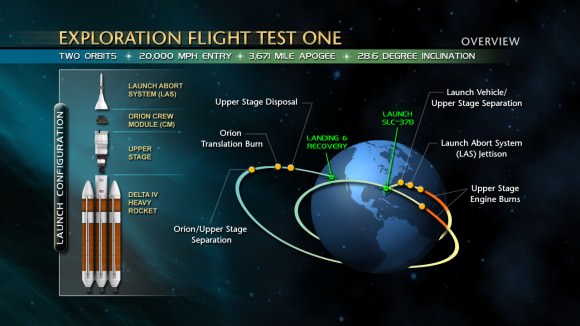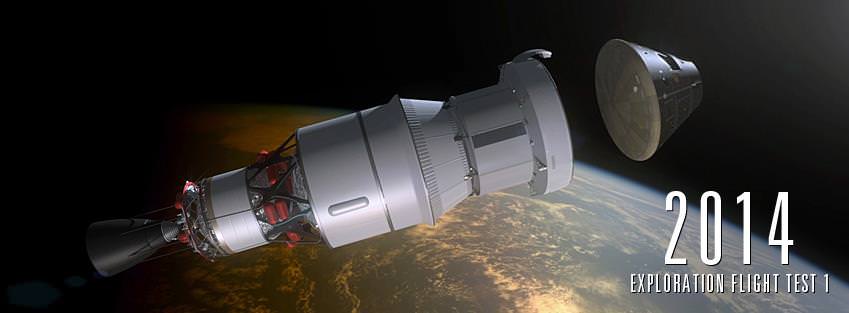[/caption]
NASA is on course to make the highest leap in human spaceflight in nearly 4 decades when an unmanned Orion crew capsule blasts off from Cape Canaveral, Fla., on a high stakes, high altitude test flight in early 2014.
A new narrated animation (see below) released by NASA depicts the planned 2014 launch of the Orion spacecraft on the Exploration Flight Test-1 (EFT-1) mission to the highest altitude orbit reached by a spaceship intended for humans since the Apollo Moon landing Era.
Orion is NASA’s next generation human rated spacecraft and designed for missions to again take humans to destinations beyond low Earth orbit- to the Moon, Mars, Asteroids and Beyond to deep space.
Orion Video Caption – Orion: Exploration Flight Test-1 Animation (with narration by Jay Estes). This animation depicts the proposed test flight of the Orion spacecraft in 2014. Narration by Jay Estes, Deputy for flight test integration in the Orion program.
Lockheed Martin Space Systems is making steady progress constructing the Orion crew cabin that will launch atop a Delta 4 Heavy booster rocket on a two orbit test flight to an altitude of more than 3,600 miles and test the majority of Orion’s vital vehicle systems.
The capsule will then separate from the upper stage, re-enter Earth’s atmosphere at a speed exceeding 20,000 MPH, deploy a trio of huge parachutes and splashdown in the Pacific Ocean off the west coast of California.
Lockheed Martin is responsible for conducting the critical EFT-1 flight under contract to NASA.
Orion will reach an altitude 15 times higher than the International Space Station (ISS) circling in low orbit some 250 miles above Earth and provide highly valuable in-flight engineering data that will be crucial for continued development of the spaceship.

“This flight test is a challenge. It will be difficult. We have a lot of confidence in our design, but we are certain that we will find out things we do not know,” said NASA’s Orion Program Manager Mark Geyer.
“Having the opportunity to do that early in our development is invaluable, because it will allow us to make adjustments now and address them much more efficiently than if we find changes are needed later. Our measure of success for this test will be in how we apply all of those lessons as we move forward.”
Lockheed Martin is nearing completion of the initial assembly of the Orion EFT-1 capsule at NASA’s historic Michoud Assembly Facility (MAF) in New Orleans, which for three decades built all of the huge External Fuel Tanks for the NASA’s Space Shuttle program.
In May, the Orion will be shipped to the Kennedy Space Center in Florida for final assembly and eventual integration atop the Delta 4 Heavy rocket booster and launch from Space Launch Complex 37 at nearby Cape Canaveral. The Delta 4 is built by United Launch Alliance.
The first integrated launch of an uncrewed Orion is scheduled for 2017 on the first flight of NASA’s new heavy lift rocket, the SLS or Space Launch System that will replace the now retired Space Shuttle orbiters
Continued progress on Orion, the SLS and all other NASA programs – manned and unmanned – is fully dependent on the funding level of NASA’s budget which has been significantly slashed by political leaders of both parties in Washington, DC in recent years.
…….
March 24 (Sat): Free Lecture by Ken Kremer at the New Jersey Astronomical Association, Voorhees State Park, NJ at 830 PM. Topic: Atlantis, the End of Americas Shuttle Program, Orion, SpaceX, CST-100 and the Future of NASA Human & Robotic Spaceflight


Nice. But the captions wrote Altitude. Mr. Kremer said attitude at 1:58 referring to Orion’s reentry.
Just sayin….
Maybe you are thinking of Jay Estes, the narrator?
Oh, whatever. You have too many dots above one of your Os. 😛
Dragon has already done 90% of this test flight at a fraction of the cost. The extra money required for this test flight should be used to speed up multiple comercial crew options rather than perform 1 test flight that does not achieve any more than already done by Dragon at a fraction of the cost. The high orbit achieves higher re-entry speed than LEO but not sufficient for Lunar or other deep space mission so does not prove the syatem any more than LEO orbit and extrapolate the higher speed.
Dragon’s internal capacity = 10 m3 Orion’s internal capacity = 19.56 m3. Orion is designed with Lunar missions in mind. Dragon isn’t and so would have to be re-designed to get to the moon, or a whole new craft designed from scratch. AresV also has TLI payload of 60,000 odd KGs. Dragon doesn’t get us to the moon, and therefore doesnt get us anywhere we cant already go with existing systems.
Orion is indeed, much more spacious, but Dragon is a more spacious than Apollo (5.9 m3). Dragon has the right heat-shield to survive re-entry from lunar and Mars velocities, SpaceX claims. What is needed is expanded life support-and propulsion systems housed within the Dragon trunk, becoming a service module. A total redesign sounds extreme. I’m not saying we should abandon Orion and SLS–they are very powerful, and it helps. The point is that Dragon and Falcon Heavy could work, too–with multi-launch and solar-electric cargo carriers, however.
For Constellation/Orion, the Altair lander was supposed to do most of the propulsive work anyway… the braking into Lunar Orbit was to be done by the lander not by the mothership as it was handled by Apollo. No reason Dragon couldn’t follow the same method.
“Dragon isn’t and so would have to be re-designed to get to the moon, or a whole new craft designed from scratch. ”
Be advised that the heat shield of Dragon was designed from the start to handle re-entry speed from Lunar and interplanetary distances (making it well overbuilt for Earth orbital re-entry)
It will take more than that to be deep-space capable of course, but yes they were thinking that far ahead…
That as opposed to Boeing’s CST-100 which doesn’t pretend to be anything but an orbital taxi to ISS or other stations, and for its electrical power uses only batteries, not fuel cells or (like Orion and Dragon) solar panels.
The SLS will not replace any function of the STS what I can see, except trivially as the same type of pork politician money drain.
Unless a) it is used as a (tremendously expensive) backup to the current and future crew and cargo transportation to ISS b) you are thinking of constructing a replacement to ISS.
SLS is projected to be used for NEO and further crew exploration, something STS was never capable of.
The Payload Bay for the X37B is only 7 × 4 ft (2.1 × 1.2 m) you call that a replacement all it is, is a recoverable spy satellite.
And three of the four Commercial Space providers of manned access to ISS would use the same Atlas V rocket to reach orbit that launched the X-37b.
(The SoaceX Dragon has its own ride, the Falcon 9. And the Blue Origin vehicle will switch to its own company’s recoverable launcher, whenever it becomes operational.)
ps. the falcon heavy launch vehicle only has 19,000kgs to Geo orbit. less than 1/3 what AresV could send to the moon.
Some may argue multi-launch, saying it would be more affordable than a single Ares V (not being built) launch with all your eggs in one basket. Launch fuel and tanks first, then the hardware. Factor in solar electric propulsion to carry the heavy stuff from LEO to LLO long before crew arrival. Efficiency is better than brute force, they say. I’d say it’s not only the size that counts, it’s how you use it.
That’s a lot of launches to build a station on the moon. 3 launches by a falcon heavy plus another launch to take up the ion drive to take it to the moon just to match what AresV can do, and then how many months for the ion drive to get the stuff there?
Hope no ones injured or sick and needs the equipment in a hurry.
AresV is not being built; why compare? The current plan is the more reasonably sized 130 mT to LEO version with SLS, not launching until 2030 they say. The 70-to-100 mT version of SLS is what we have to settle for a while, and outperforms Falcon Heavy to LEO by 20-to-50 more tonnes. What really counts is cost effectiveness and sustainability, that is, it boils down to $$ per kg. A smaller rocket launched often may be preferable than a bigger, more expensive launch vehicle launched sporadically.
For moon bases, for almost any destination, high launch rates are likely to be unavoidable. If there anyone gets hurt up there, they should have their medical equipment already place before they land. We are not gonna get 188 mT to LEO in a single launch. So we have to use whatever we will have more wisely. Maximizing payloads with electric/ion propulsion.
My point is that it should be being built. Once built, the AresV would be the cheaper option. Talking about it is the same as comparing HDDVD to Blueray. or 8Track to casset or Beta to VHS. It may not be going to happen. That does not mean that it shouldn’t
the video speaker should lower his enthusiasm 😛
Well with the new laws passed like the NDAA, laws they want passed like SOPA and ACTA will only make the country more militarized, you can kiss NASA’s budget goodbye in the next 5 years.
Nobody seems to care, and the only ones promoting space are the lunatic Gingrich-sheep. It’s all “the money would be better spent down here than up there.” But what are we spending the money on? War machines which do no good for humanity.
Wish more people saw that point of view
2014 projected test = 2016 actual test?
If I understand correctly, this mission will eventually put a manned capsule in orbit around the moon or mars? There will be no landing, right? Could someone tell me the use of this? What can human eyes see what equipment can’t? Why would anyone even put a human in orbit around the moon or mars for that matter? Except for the awesome experience, of course 😉
Putting humans in orbit around Mars would still have advantages over robots. For one, landings could be made on the moons (and with no atmosphere and little gravity, it would be a relatively simple procedure). True, a robot could land there, but when it comes to selecting and grabbing samples for return to Earth, nothing is going to beat a human in performance.
Second, the trip would be a useful learning experience, allowing us to refine technologies, equipment and procedures in advance of an eventual trip that culminates in a landing. The interplanetary trip itself is something that’s never been done before – and putting humans in orbit of the moon long-term would be excellent preparation.
Third, it would be awesome.
People in space, on the moon and even Mars inspires people.
No robot gives the same inspiration.
Also the lessons learned how people behave and live in space are very great.
A lot of technology can come from this, that might be used for deep sea divers or medical facilities. Portable medical scanners, food processing and storage, water processing and recycling,…